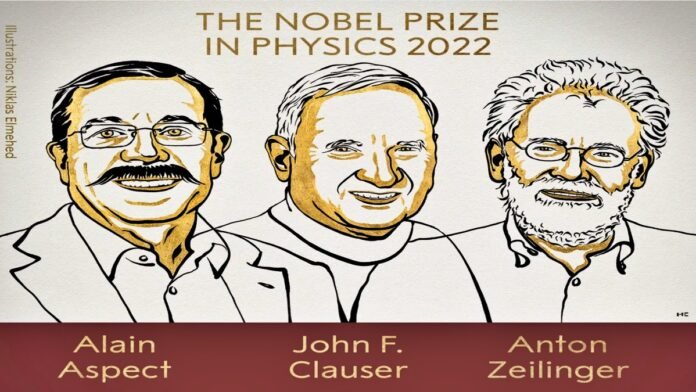
Key Points:
- John Clarke, Michael Devoret, and John Martinis of United States receive 2025 Nobel Prize in Physics
- Royal Swedish Academy of Sciences announced winners at 3:15 PM Swedish time on October 7
- Laureates recognized for demonstrating quantum mechanical tunneling and quantized energy levels in hand-held electrical circuits
- Discovery enables macroscopic observation of quantum phenomena previously limited to microscopic particles
- Breakthrough advances quantum technology applications including quantum computers, cryptography, and sensors
- Prize includes 11 million Swedish kronor (₹10.3 crore), gold medal, and certificate
- Award ceremony scheduled for December 10 in Stockholm
- Since 1901, Physics Prize awarded to 118 scientists; Sir C.V. Raman first Indian recipient in 1930
New Delhi: The Royal Swedish Academy of Sciences announced today that the 2025 Nobel Prize in Physics has been awarded to three American scientists John Clarke, Michael Devoret, and John Martinis for their revolutionary work demonstrating quantum mechanical phenomena at a scale visible to the human eye. The prestigious honor recognizes their groundbreaking experiments with electrical circuits that have bridged the gap between the mysterious quantum world and everyday macroscopic reality.
Revolutionary Quantum Circuit Experiments
The three laureates conducted pioneering experiments using specially designed electrical circuits that successfully demonstrated two fundamental quantum mechanical principles: quantum tunneling and quantized energy levels. What makes their achievement extraordinary is that these quantum behaviors were observed in systems large enough to be held in one’s hand a remarkable feat given that quantum mechanics traditionally applies only to subatomic particles invisible even under conventional microscopes.
Quantum tunneling is a phenomenon where particles pass through energy barriers that should be impenetrable according to classical physics. Quantized energy levels refer to the discrete, step-like energy states that quantum systems can occupy, rather than the continuous energy spectrum seen in classical systems. Until these experiments, such behaviors were considered exclusive to the microscopic realm of electrons, photons, and atoms.
Bridging Microscopic and Macroscopic Worlds
The significance of this research lies in successfully scaling quantum mechanical effects from the atomic level to macroscopic dimensions. Previously, quantum mechanics was understood to govern the behavior of extremely small particles—electrons, protons, and photons—whose dimensions measure in nanometers or smaller. These particles exhibit behaviors so counterintuitive that they defy everyday human experience and classical physics principles.
Clarke, Devoret, and Martinis engineered electrical circuits using superconducting materials and specialized components that preserve quantum coherence even at relatively large scales. This preservation of quantum properties in macroscopic systems represents a fundamental breakthrough, as quantum effects typically disappear when systems interact with their environment—a phenomenon known as decoherence.
Quantum Technology Applications
The laureates’ discoveries have profound implications for emerging quantum technologies that promise to revolutionize computing, communication, and sensing capabilities. Their work forms the foundation for several critical applications currently under development worldwide.
Quantum Computing: The electrical circuit architectures developed by these scientists serve as the basis for superconducting quantum computers, which use quantum bits (qubits) to perform calculations impossible for classical computers. Companies and research institutions globally are racing to build practical quantum computers using these principles.
Quantum Cryptography: The ability to manipulate quantum states in controlled electrical systems enables ultra-secure communication methods. Quantum cryptographic protocols exploit quantum mechanical properties to create theoretically unbreakable encryption, protecting sensitive information from even the most sophisticated hacking attempts.
Quantum Sensors: Macroscopic quantum systems enable unprecedented measurement precision. Quantum sensors based on these principles can detect minute magnetic fields, gravitational waves, and other phenomena with sensitivities far exceeding conventional instruments, opening new frontiers in scientific research and medical diagnostics.
Historical Context and Significance
The Physics Nobel Prize carries exceptional prestige in the scientific community, recognizing discoveries that fundamentally advance human understanding of nature’s laws. Since the award’s inception in 1901, it has been bestowed upon 118 scientists whose work shaped modern physics and technology.
The youngest recipient was Lawrence Bragg, who received the honor at age 25 in 1915 for X-ray crystallography work conducted with his father. At the opposite end of the spectrum, Arthur Ashkin became the oldest laureate at 96 years in 2018 for inventing optical tweezers that manipulate microscopic particles using laser beams.
Indian Legacy in Physics Nobel
The first Indian scientist to receive the Physics Nobel Prize was Sir Chandrasekhara Venkata Raman in 1930, recognized for discovering what became known as the Raman effect. His groundbreaking work demonstrated that light changes wavelength (and therefore color) when it scatters from molecules, revealing information about molecular structure and composition.
The Raman effect has become an indispensable tool in modern science and technology. Raman spectroscopy is widely employed in pharmaceutical quality control, materials science, forensic analysis, and medical diagnostics. The technique enables non-destructive chemical analysis and has applications ranging from detecting counterfeit drugs to identifying cancerous tissues during surgery.
Sir C.V. Raman’s legacy continues to inspire Indian scientists and represents a proud chapter in India’s scientific heritage, demonstrating that groundbreaking discoveries can emerge from any corner of the globe.
Prize Details and Recognition
The 2025 Physics Nobel Prize carries a monetary award of 11 million Swedish kronor, equivalent to approximately ₹10.3 crore. When multiple laureates share the prize, as in this year’s three-way award, the prize money is divided equally among them. Each recipient will also receive an individually crafted gold medal bearing Alfred Nobel’s profile and a personalized certificate featuring unique artwork.
The official award ceremony is scheduled for December 10, coinciding with the anniversary of Alfred Nobel’s death. The ceremony will take place in Stockholm, Sweden, in the presence of the Swedish Royal Family and dignitaries from around the world. The event represents one of science’s most prestigious occasions, celebrating human achievement in expanding knowledge frontiers.
Nobel Prize Selection Process
The Royal Swedish Academy of Sciences oversees the Physics Nobel Prize selection through a rigorous process spanning nearly a year. Nominations are solicited from previous laureates, distinguished professors, and members of scientific academies worldwide. The Nobel Committee for Physics evaluates nominations, consults expert reviewers, and ultimately recommends recipients to the full Academy for approval.
The selection criteria emphasize discoveries of fundamental importance that have significantly benefited humanity. The Nobel Prize statutes stipulate that awards can only be given to living individuals and may be shared by up to three people, though the honored work need not have been conducted jointly.
Scientific Impact and Future Directions
The work of Clarke, Devoret, and Martinis has already catalyzed extensive research programs globally. Universities, government laboratories, and technology companies have invested billions in developing quantum technologies based on superconducting circuits. Their discoveries have spawned new scientific subfields and engineering disciplines focused on harnessing quantum mechanics for practical applications.
Looking forward, the macroscopic quantum systems pioneered by these laureates may enable technologies currently considered science fiction, including large-scale quantum computers capable of solving previously intractable problems in drug discovery, materials design, artificial intelligence, and climate modeling. Quantum networks could create unhackable communication infrastructures, while quantum sensors might detect gravitational waves from the universe’s earliest moments or identify diseases at their molecular origins.
Advancing Human Knowledge
This year’s Physics Nobel Prize exemplifies how fundamental scientific research, driven by curiosity about nature’s deepest principles, ultimately yields transformative technologies. Clarke, Devoret, and Martinis embarked on their experimental journeys to test quantum mechanical predictions and explore the boundaries between microscopic and macroscopic worlds. Their discoveries now stand poised to reshape computing, communication, and measurement technologies in the 21st century.
The award underscores the continuing relevance of quantum mechanics, a century after its initial development, and demonstrates that profound mysteries about the quantum-classical boundary still await exploration. As humanity ventures further into the quantum technological revolution, the foundational work of these three American scientists will be remembered as a pivotal moment when the strange quantum world became tangible, controllable, and useful at human scales.










































